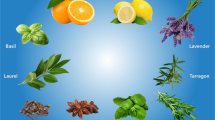
Overview
- Provides to the market the only edited book that covers on functionality of cyclodextrin powder in encapsulation for food applications
- Presents essential information on technologies to encapsulate active components using cyclodextrin powders, and characteristics and applications in food production of formed complexes
- Covers a broad range of applications of cyclodextrin in encapsulation of guest molecules, including: gases, flavors, colors, pigments, polyphenols (plant bioactive compounds), essential oils, lipids (cholesterol and polyunsaturated fatty acids), vitamins, fruit ripening controlling compounds, and antifungal and antimicrobial compounds
Access this book
Tax calculation will be finalised at checkout
Other ways to access
About this book
Cyclodextrins (CD) are cyclic oligosaccharides containing 6, 7 or 8 glucose units (α, β or γ-CD, respectively) in a truncated molecular shape. Their cyclic molecular structure contains a hydrophilic surface and a hydrophobic cavity at the center that can interact (host) with external hydrophobic compounds (guest molecules). Cyclodextrins have been categorized as Generally Recognized As Safe (GRAS) in the USA, “natural products” in Japan, and as “novel food” in Australia, New Zealand and EU countries. They are therefore widely used in food production to encapsulate hydrophobic compounds, including solid, liquid and gas molecules, in order to solubilize, stabilize or control the release rate of these components. To date, there has been no comprehensive review of the very large number of studies performed on encapsulation using cyclodextrin powders for food applications in recent years.
This text fills that gap for academics in the encapsulation field and for industry professionals who want to gain a solid understanding of encapsulation functionality of cyclodextrin powders. The book consists of 16 chapters in which chapter 1 introduces cyclodextrin properties and its applications in food processing, and chapters 2-16 explore applications of cyclodextrin in encapsulation for many guest compounds. These compounds include gases, flavors, colors, pigments, polyphenols (plant bioactive compounds), essential oils, lipids (cholesterol and polyunsaturated fatty acids), vitamins, fruit ripening controlling compounds, and antifungal and antimicrobial compounds. These chapters also discuss functionalities of cyclodextrin in packaging, masking off-flavor and off-taste, and as dietary fiber.
Covering a broad range of cyclodextrin applications and suitable for both newcomers to encapsulation technology and those with experience, Functionality of Cyclodextrins in Encapsulation for Food Applications is a unique and essential reference on this increasingly important topic.
Similar content being viewed by others
Keywords
Table of contents (16 chapters)
-
Front Matter
-
Back Matter
Editors and Affiliations
About the editors
Thao M. Ho is a Postdoctoral Researcher in the Department of Food and Nutrition at the University of Helsinki in Helsinki, Finland and an Honorary Fellow in the School of Agriculture and Food Sciences at the University of Queensland in Brisbane, Australia.
Hidefumi Yoshii is a Professor of Food Engineering Lab in the Department of Food Science and Human Nutrition at Setsunan University in Osaka, Japan and the Emeritus Professor of Kagawa University in Takamatsu, Japan.
Keiji Terao is the President of CycloChem Bio Co., Ltd. in Kobe, Japan and a Guest Professor in the Graduate School of Medicine at Kobe University in Kobe, Japan.
Bhesh R. Bhandari is a Professor of Food Engineering in the School of Agriculture and Food Sciences at the University of Queensland in Brisbane, Australia.
Accessibility Information
Bibliographic Information
Book Title: Functionality of Cyclodextrins in Encapsulation for Food Applications
Editors: Thao M. Ho, Hidefumi Yoshii, Keiji Terao, Bhesh R. Bhandari
DOI: https://doi.org/10.1007/978-3-030-80056-7
Publisher: Springer Cham
eBook Packages: Biomedical and Life Sciences, Biomedical and Life Sciences (R0)
Copyright Information: The Editor(s) (if applicable) and The Author(s), under exclusive license to Springer Nature Switzerland AG 2021
Hardcover ISBN: 978-3-030-80055-0Published: 07 October 2021
Softcover ISBN: 978-3-030-80058-1Published: 08 October 2022
eBook ISBN: 978-3-030-80056-7Published: 06 October 2021
Edition Number: 1
Number of Pages: XI, 343
Number of Illustrations: 64 illustrations in colour
Topics: Food Microbiology, Food Science, Organic Chemistry



